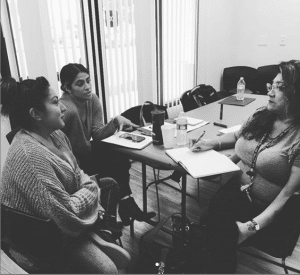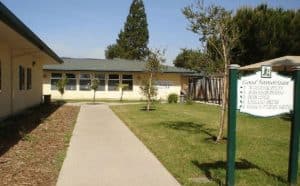BY DEAN ZATKOWSKY (Contributor) | LEER EN ESPAÑOL
During a tour of the Good Samaritan Shelter in Santa Maria, Director of Homeless Services Kirsten Cahoon said something that caught our ear: “Right now there are some children in the main shelter, because the family shelter is always full.”
Always full?

“Yes. The family shelter is always full. The Safe House (for survivors of human trafficking) is at capacity too.”
Is everything full?
“Yes, everything is often full. We’ve had to turn away people showing up at our door. We’ve seen an increase in families becoming homeless in our area. Parents are working, but it’s not enough to afford a rental in this community. With less than a 2% vacancy rate, we’re just seeing more families fall into homelessness.”
Homelessness in Santa Barbara County, both chronic and temporary, seems like an intractable problem, but organizations like Good Samaritan Shelter, Doctors Without Walls – Santa Barbara Street Medicine, Transition House, Santa Ynez Valley People Helping People, New Beginnings Counseling Center, and others are working on it anyway.
Good Samaritan Shelter is the largest provider of shelter and services to the homeless and those in recovery along the Central Coast of California, offering a wide range of services, including emergency shelter for adults and families, family shelter, permanent housing, residential detoxification, outpatient drug and alcohol treatment, mental health services, residential perinatal treatment, children’s after-school programming, clean and sober living homes, supportive services for veteran families, and more.
Because of Good Samaritan’s focus on those in recovery, we asked Cahoon which came first, substance abuse or homelessness? “People become homeless for many reasons, but homelessness itself is traumatic and stressful, and many people self-medicate. If you need to sleep outdoors and its cold, being under the influence may be an option for not feeling the cold.”
Like others we interviewed about homelessness in Santa Barbara County, Cahoon noted the devastating combination of low-paying jobs and high rents. “Our clients are working, they are clean and sober and doing the things society thinks they should do. And we have lots of jobs in this area, thank goodness, but they’re not high paying jobs. Lots of us are one paycheck away from homelessness. We shelter realtors, teachers, property managers; I’ve seen professionals here, people whose children go to school with mine. These are our neighbors.”

Cahoon adds, “We have an aging population of homeless too, who are trying to make it on $895 per month in Social Security. Where in Santa Barbara County are you going to find somewhere to live on $895 per month?”
As Santa Barbara County’s nonprofits address homelessness, new challenges constantly appear. According to Doctors Without Walls – Santa Barbara Street Medicine Medical Director Jason Prystowsky, “The needs are always shifting and we continue to adapt. Fortunately, we are part of an extraordinary network of people and organizations that are consistently looking at innovative ways to address the health needs of our most vulnerable. Sometimes we have to be creative in our methods and approach.”
And the challenges go beyond finding innovative ways to provide services. Concerned that the general public has become blind to homelessness, Santa Ynez Valley People Helping People (PHP) CEO Dean Palius added a Homelessness FAQ to the organization’s website. It opens with this statement:
“Homelessness has proven to be a tough problem to solve. It is difficult to see someone trying to survive on the streets, in their car, in a park, or in the riverbed. Our reactions range from fear and anger to compassion and pity. Very often we choose not to see the person and avoid eye contact. As hard as it may be to witness the personal difficulties of others, we encourage all Valley residents to exercise empathy. Imagine for yourself what it’s like to have no home and no support network, to be cold or hungry or sick, to have so many in better situations in life walk by you each day as if you were invisible.”
Invisibility is a particular challenge for those who actually get homeless people off the streets. According to Cahoon, “I don’t think the community understands the scale of what we do. We are the biggest provider of substance-abuse treatment. We provide mental health treatment. We provide permanent housing. On any given night, there are 500 people sleeping at our emergency shelters. That is a lot of people off the streets and receiving services. I don’t know if the community can visualize the magnitude, or what it would look like if we weren’t here.”
Good Samaritan Shelter may be the biggest, but new challenges keep reminding Cahoon that they are not big enough. “The bigger nonprofits do have multiple funding streams, and we do get a lot of government grants and support, but we all still rely on private donations to grow our organizations and solve emerging problems. A few years ago we didn’t know we needed a safe house for survivors of human trafficking – now it’s open and at capacity. And these clients have the highest needs of any of our clients.”
She also expressed gratitude to be included in this article, because even though they rely on private donations, “We don’t do a lot of PR or fundraising. We’re putting out fires all day every day with our clients.”
SBF, in partnership with our donors, has awarded grants over the last five years (in total) to the mentioned organizations: Good Samaritan Shelter ($259,300), Santa Ynez Valley PHP ($220,810), Transition House ($797,570), Doctors Without Walls ($151,350), and New Beginnings Counseling Center ($157,650).